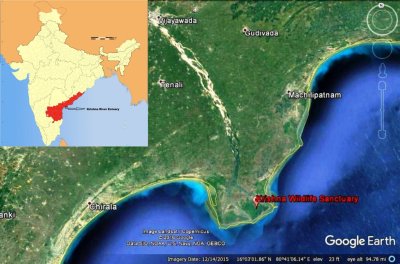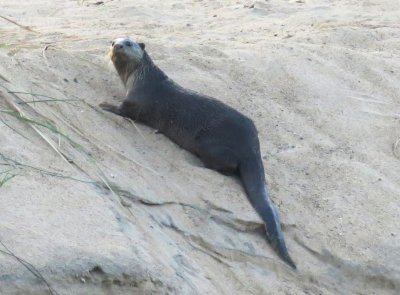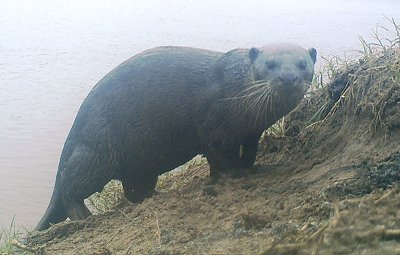IUCN/SSC Otter Specialist Group Bulletin

©IUCN/SCC Otter Specialist Group
Volume 34 Issue 1 (January 2017)
Citation: Kantimahanti, M and Allaparthi, AR (2017). Records of Smooth-Coated Otter Lutrogale perspicillata (Geoffroy, 1826) from the Krishna River Delta of South India. IUCN Otter Spec. Group Bull. 34 (1): 58 - 63
Records of Smooth-Coated Otter Lutrogale perspicillata (Geoffroy, 1826) from the Krishna River Delta of South India
Murthy Kantimahanti1 and Appa Rao Allaparthi1
1 Conservation Biologist, Eastern Ghats Wildlife Society,
Flat-104, Shree Towers, Vepagunta, Visakhapatnam-530047, Andhra
Pradesh, India. Email: klnmurthy25@gmail.com
Member, SUPPORT, Repalle, Andhra Pradesh, India


|
| (Received 30th October 2016, accepted 30th January 2017) |
| Download PDF (1 MB) |
| Abstract: There have been no detailed studies on distribution and status of Smooth-coated Otter Lutrogale perspicillata from the Krishna river delta in coastal Andhra Pradesh of South India, although the area holds a population potentially important for the species’ conservation. Some interactions between local fishing communities and Smooth-coated Otters in the region have led to retaliatory killings. This negative situation beckons for conservation attention. Smooth-coated otters were observed in a few locations along the river banks and mangrove areas of Krishna Estuary. The potential threats for its survival highlight the need to prioritize this region as an important conservation area through further intensive surveys. |
| Keywords: Smooth-coated Otter, Krishna River, Mangroves, Andhra Pradesh. |
| Française | Español |
The eastern coastal plain of the state of Andhra Pradesh in South India is vast with highly fertile deltas of the Godavari and Krishna rivers flowing through the Eastern Ghats hill ranges. The Smooth-coated Otter is distributed throughout India from Himalayas southwards and has been reported from the states of Karnataka, Kerala, Andhra Pradesh, Madhya Pradesh, Maharastra, Gujarat, Punjab, Himachal Pradesh, Uttar Pradesh, Bihar, West Bengal and Mizoram (Prater, 1971; Hussain and Choudhary, 1988; Hussain, 1993; Foster-Turley and Santiapillai, 1990). It is seen to inhabit large rivers and their associated tributaries, estuaries and coastal mangrove swamps, and requires undisturbed forest or scrub adjacent to the water (Mason, 1990).However, all three species of otters found in India are becoming increasingly rare outside protected areas and are threatened in many locations by a reduction in prey biomass, poaching and loss of habitat (Foster-Turley et al., 1990; Hussain, 2002). There is also lack of information on the status of otter populations in India (Hussain, 1993). We present a few incidental sightings, camera trap images and indirect evidences (tracks, spraints and den sites) of Smooth-coated Otter along the Krishna River Delta which came out as ancillary observations during a species targeted survey for the fishing cat (Table 1).
The Krishna River originates from Mahabaleshwar in Western Ghats at height of approximately 1337 meters above mean sea level and flows 1400 kilometres eastwards through the Eastern Ghats to meet Bay of Bengal in Andhra Pradesh. Tropical mangrove forests spread out over 250 Square kilometres that lay at the river mouth along the east coast of Central Andhra Pradesh form the Krishna Wildlife Sanctuary (Figure 1). The sandy banks with native riparian vegetation as well as the tidal habitat towards the coast provide an ideal refuge for smooth-coated otters in the area. We report the records from unprotected areas around the Krishna Wildlife Sanctuary.
 |
| Figure 1. A view of the Krishna River along the east coast of South India. (click for larger version) |
From April 2015 to October 2016, we directly sighted smooth-coated otters in small family groups of 3-5 individuals at few locations along the river bed, on isolated river islands and in the mangrove creeks outside the protected areas. Indirect evidences like den sites, spraints and tracks were also recorded at some locations along the river banks. Smooth-coated otters are social carnivores that forage in groups and use communal sites for defecation (Hussain, 1996; Hussain and Choudhury, 1997). A video of an otter family returning to the same latrine site regularly to defecate was recorded on a LED flash camera trap which was originally installed to capture small wild cats.
Smooth-coated Otters play a key role in the freshwater ecosystem as top carnivores that help control the populations of species they prey on and therefore, contribute to the overall health and functioning of the ecosystem over a period of time (Khan et al., 2014).The species is listed as Vulnerable (VU) by the International Union for the Conservation of Nature (de Silva et al, 2015) and Natural Resources and is on appendix II of the Convention on International Trade in Endangered Species. However, informal interactions with our local informants revealed that as many as 40 otters were killed by fish farmers near Rajula Cheruvu and Lankavani Dibba areas in the past two years due to perceived threat to their economy since otters predate on commercial fish stocks in aquaculture ponds and their meat was also consumed by the locals We also documented otter road kills on the Krishna River left flood bank road which runs parallel to the main stream river from Vijayawada city to Puligedda town. Indiscriminate sand mining from the river bed has also been observed. Furthermore, the local villagers confirmed poaching of otters in the region by organized gangs who are nomadic and operate seasonally. Therefore, we propose immediate conservation measures to address predation conflict in the area and initiation of otter population distribution surveys coupled with awareness generation activities among all the stakeholders in the region.
Acknowledgements: Authors are grateful to the local communities for their generous support and hospitality during the field work. Special thanks are also due to the Andhra and capacity and to Pradesh Forest Department for their encouragement.
REFERENCES
de Silva, P., Khan,
W.A., Kanchanasaka, B., Reza Lubis, I., Feeroz, M.M., Al-Sheikhly, O.F. ( 2015). Lutrogale
perspicillata . The IUCN Red List of Threatened Species 2015e T12427A21934884.[http://dx.doi.org/10.2305/IUCN.UK.2015-2.RLTS.T12427A21934884.en.
Downloaded on 28 October 2016]
Foster-Turley, P.,
Santiapillai, C. (1990). Action
plan for Asian Otters. In: Foster-Turley, P., Macdonald, S.M., Mason,
C.F. (eds.) Otters: An action plan for their conservation. IUCN/SSC
OSG, IUCN Gland Switzerland. 52-63.
Foster-Turley, P.,
Macdonald, S., Mason, C. (1990). Otters.
An action plan for their conservation. IUCN/SSC Otter Specialist Group.
Hussain, S.A. (1993). Aspects
of ecology of smooth-coated Indian otter, Lutra perspicillata ,
in National Chambal Sanctuary. Ph. D. Thesis. Aligarh Muslim University,
Aligarh, India.
Hussain, S.A., Choudhary,
B.C. (1988). A preliminary
survey of the status and distribution of the smooth-coated otter, Lutra
perspicillata , in the National Chambal Sanctuary. Proc. I. Int.
Seminar Asian Otters. October, 1988, Bangalore, India .
Hussain, S.A. (2002). Conservation
status of otters in the Tarai and lower Himalayas of Uttar Pradesh, India. Proceedings
of the VII International Otter Symposium , 13-19 March 1998, Trebon,
Czech Republic. Dulfer, R., Conroy, J., Nel, J., Gutleb, A.C. (Eds.) IUCN
Otter Spec. Group Bull. 19A , 131-142.
Hussain, S.A. (1996). Group
size, group structure and breeding in smooth-coated otter Lutra perspicillata Geoffroy
(Carnivora,Mustelidae) in National Chambal Sanctuary. Mammalia 60 :
289-297.
Hussain, S.A., Choudhury,
B.C. (1997). Distribution
and status of the smooth-coated otter Lutra perspicillata in
National Chambal Sanctuary, India. Biol. Conserv . 80 :
199–206.
Khan, M.S., Dimri,
N.K., Nawab, A., Ilyas, O., Gautam, P. (2014). Habitat
use and conservation status of Smooth-coated Otters Lutrogale perspicillata in
Upper Gangetic Basin, India. Ani.Biodiv. Conserv . 37:
69-76.
Mason, C. (1990). An
introduction to Otters. In: Foster-Turley, P., Macdonald, S.M., Mason,
C.F., (eds.) Otters: An action plan for their conservation. IUCN/SSC
OSG, IUCN Gland Switzerland.pp. 4-7.
Prater, S.H. (1971). The
Book of Indian Animals. 3rd edition. B. N. H. S., Bombay, India.
Résumé : Enregistrements
de Loutres à Pelage Lisse Lutrogale perspicillata (Geoffroy,
1826) provenant du Delta de la Riviere Krishna du Sud de l’Inde
Il n’existe pas d’études détaillées sur la distribution
et le statut des loutres à pelage lisse concernant le delta de la
rivière Krishna dans la zone côtière Andhra Pradesh du sud de l’Inde,
même si cette zone accueil une population potentiellement importante
pour la conservation de l’espèce. Quelques interactions entre les
communautés locales de pécheurs et les loutres à pelage lisse ont
mené à des tueries de représailles. Cette situation négative attire
l’attention à la conservation. Les loutres à pelage lisse ont été
observes au niveau de quelques emplacements le long des berges de
la rivière et des zones de mangrove du delta de la rivière Krishna.
Les potentielles menaces pour la survie de ces loutres soulignent
le besoin de faire de cette région une zone prioritaire quant à la
conservation au travers de nombreuses veilles.
Revenez au dessus
Resumen: Registros de la Nutria Lisa Lutrogale perspicillata (Geoffroy,
1826) del Delta del Río Krishna, India del Sur
No ha habido estudios detallados sobre la distribución y status de la nutria
lisa Lutrogale perspicillata del delta del río Krishna, en la parte costera
de Andhra Pradesh, Sur de la India, aunque el área alberga una población
potencialmente importante para la conservación de la especie. Algunas interacciones
entre las comunidades locales de pescadores y las nutrias lisas en la región,
han conducido a matanzas retaliatorias. Esta situación negativa requiere
atención desde la conservación. Las nutrias lisas fueron observadas en unas
pocas localizaciones a lo largo de las barrancas del río y áreas de manglar
en el Estuario Krishna. Las amenazas potenciales para su supervivencia refuerzan
la necesidad de priorizar esta región como un área importante para la conservación,
a través de ulteriores relevamientos intensivos.
Vuelva a la tapa


